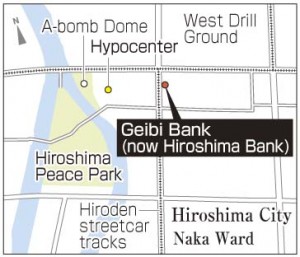Hiroshima: 70 Years After the A-bombing: Close-range Survivors 6
Aug. 25, 2014
Chiyoko Mitsufuji, 90: Nichiren chant
At Geibi Bank at time of A-bombing
Continued chanting amid sea of flames
According to the Ministry of Health, Labor and Welfare, 192,719 people held Atomic Bomb Survivor’s Certificates as of the end of March. Hiroshima resident Chiyoko Mitsufuji, 90, was at the head office of Geibi Bank in Kamiya-cho (now part of Naka Ward), about 260 meters east of the hypocenter, at the time of the atomic bombing. Ms. Mitsufuji (nee Shirasago) was a teller at the bank. Of the living survivors, she was likely the closest to the spot directly below where the atomic bomb exploded.
I went up to the roof of the head office of Hiroshima Bank with Ms. Mitsufuji. The eight-story bank building is in Kamiya-cho, the downtown area of the city of 1.2 million. On the roof is a bronze memorial honoring 144 victims of the A-bombing, including 23 who were at Geibi Bank, which stood on the site. Ms. Mitsufuji put her hands together in prayer before the monument and in a strong voice began to recount her experiences on August 6, 1945.
Special steel on vault
“I had just come out of the first-floor business office into a corridor with Yoshio Tagashira, assistant manager of the Deposits Section, when there was a flash. The solidly built vault was just to the north, and I may have been protected by it. [According to a bank newsletter issued in 1927, the year the five-story ferroconcrete head office building was completed, the U.S.-made vault was clad in a special kind of steel.]
“The next thing I knew, a slab of concrete was on top of me. When I crawled out from under it, I could see flames at the back of the building on the east side [where the kitchen was located]. The basement was the designated evacuation area. I started down the stairs, but then I suddenly recalled what a coworker had told me about the Kobe air raid. She said that the people in the basement had been roasted. So I turned back and went out to the main street via the back door.
“On the street was a column of soldiers and their horses that had been burned black. I was frightened and wondered where to flee to. I headed for the sweet potato field at the West Drill Ground around where the prefectural offices are now. Thinking back, flames were shooting out of the windows of the bank and nearby buildings.
“I lay down between furrows in the sweet potato field, which was filled with injured people. Every now and then there would be a boom, and a man would shout, ‘They’ve dropped another one!’ I imagine the munitions depot had caught fire. [The Hiroshima Castle area to the north was occupied by the Chugoku Military District Weaponry Division and other military facilities.] The army hospital (to the west) was also on fire. There was a sea of flames all around. It was like being in a furnace. I was terribly thirsty and in a stupor. The person next to me had grown quiet and was dead.
“About the time I thought I was going to die too, I recalled a story about Nichiren that I’d read in a novel by Shiro Ozaki. I had lost my voice, so I just intoned the Nichiren chant over and over in my mind. Then it started to rain. I caught raindrops in my hands and drank them. I sucked water from my wet ‘monpe’ trousers too. The flames had died down, so I struggled to my feet.”
Fainted in entry
The rain that Ms. Mitsufuji referred to was the black rain containing radioactive fallout. According to a report on the destruction caused by the atomic bomb prepared by the Hiroshima District Meteorological Observatory, the rain began to fall over the hypocenter around 9 a.m. and headed north-northwest and the fires burned most fiercely between 10 a.m. and 4 p.m.
Ms. Mitsufuji walked along the Hakushima streetcar line, where victims were moaning and begging for help and for water. At the Tokiwa Bridge she went down to the banks of the Kyobashi River, determined to reach her uncle’s home in Ushita (Higashi Ward). “I fainted as soon as I stepped into the entry,” she said. It was evening by the time she arrived.
Two months later she went back to work, but her health was not good so she quit her job. Her boss, Mr. Tagashira, died on September 15.
Ms. Mitsufuji still lives in the same wooden house she collapsed in 69 years ago. She raised a son and a daughter. Four years ago her husband died. She has four grandchildren and five great-grandchildren. In an interview at her home, where many photos of her family are on display, she spoke cheerfully about her life after the A-bombing.
“Until I got colon cancer at the age of 80 I was surprisingly healthy,” she said. “It must be good to be inquisitive.” Ms. Mitsufuji enjoyed mountain-climbing into her 70s and traveled around the world. At 90 she attends a cooking class, takes a history course and walks all over Kamiya-cho. “I try not to think about the A-bombing,” she said. “The thought of it makes me shudder.”
(Originally published on July 8, 2014)










